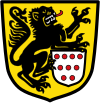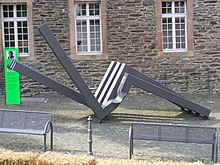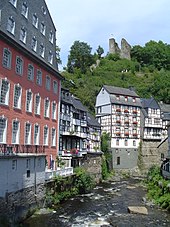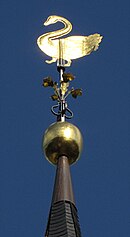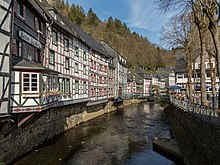Monschau
| coat of arms | Germany map | |
|---|---|---|
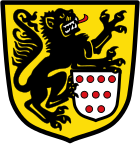
|
Coordinates: 50 ° 33 ' N , 6 ° 14' E |
|
| Basic data | ||
| State : | North Rhine-Westphalia | |
| Administrative region : | Cologne | |
| Circle : | City region Aachen | |
| Height : | 517 m above sea level NHN | |
| Area : | 94.6 km 2 | |
| Residents: | 11,693 (Dec 31, 2019) | |
| Population density : | 124 inhabitants per km 2 | |
| Postal code : | 52156 | |
| Area code : | 02472 | |
| License plate : | AC, MON | |
| Community key : | 05 3 34 020 | |
| LOCODE : | DE MOU | |
| City structure: | 7 districts | |
City administration address : |
Laufenstrasse 84 52156 Monschau |
|
| Website : | ||
| Mayoress : | Margareta Ritter ( CDU ) | |
| Location of the city of Monschau in the Aachen city region | ||
Monschau [ 'mon.ʃaʊ also ' mɔn.dʒaʊ̯ ] (until 1918 Montjoie , on August 9, 1918, the name was changed by an imperial decree in Monschau ) is a town on the Rur in the Eifel . It is located in North Rhine-Westphalia and belongs to the Aachen city region . The city lies between the mountain slopes of the Hohes Venn-Eifel nature park in the Rureifel , which takes its name from the river Rur.
geography
Neighboring towns are Simmerath , Schleiden , Hellenthal and the Belgian towns of Eupen , Weismes , Bütgenbach , Rocherath and Büllingen .
climate
The annual precipitation is 1222 mm and is thus in the upper tenth of the values recorded by the measuring points of the German Weather Service . Over 93% indicate lower values. The driest month is September; it rains most in December. In the wettest month there is around 1.8 times more rain than in the driest month. The seasonal fluctuations in precipitation are in the upper third. In over 86% of all places, the monthly precipitation fluctuates less.
City structure
The city of Monschau has consisted of the districts since 1972
- Farms with 2054 inhabitants (December 31, 2006)
- Imgenbroich with Widdau with 2010 inhabitants (December 31, 2006)
- Kalterherberg with Ruitzhof with 2432 inhabitants (December 31, 2006)
- Concentration with the homestead Rückschlag with 2428 inhabitants (December 31, 2006)
- Monschau with 1696 inhabitants (December 31, 2006)
- Mützenich with 2237 inhabitants (December 31, 2006)
- Pipes with 741 inhabitants (December 31, 2006)
The Vennbahntrasse , which belongs to the Belgian national territory, runs through the urban area, making Mützenich, Ruitzhof and Rückschlag into German exclaves enclosed by Belgium .
history

Monschau was mentioned for the first time as Mons Ioci in 1198 , the exact origin of the name cannot be determined. Different names or spellings have been used over the years, for example: 1225 de Munioy, 1226 Monjoje, 1248 de Monsyoge, 1251 de Můns Yoia, 1279 de Munzoyge, 1338 de Muynzie, 1354 de Monyou, 1364 zu Moynschawe, 1384 Monzwauwe, 1429 zu Monschauwe. Before it was renamed Monschau by imperial decree of Wilhelm II in 1918, the city was called Montjoie.
Probably at the beginning of the 13th century , the Monschau Castle was built as a castrum in Munioie by the Dukes of Limburg and expanded in the 14th century. It lies above the Rur valley, where the Laufenbach flows into the Rur. Today the older of the two youth hostels in Monschau is located in the renovated castle.
In 1352 Montjoie received city rights. The rule of Montjoie went after the death of John III. from Schönforst -Montjoie to the Duchy of Jülich in 1433 .
In 1596, a leper colony was established in Montjoie .
The city population increased in the Thirty Years War due to numerous Protestant German-speaking refugees and cloth makers in search of religious freedom .
Incorporations
On January 1, 1972, the previously independent communities of Höfen, Imgenbroich, Kalterherberg, Konzen, Mützenich and Rohren were incorporated into the city of Monschau.
Textile industry
The founder of Monschau fine cloth production is considered to be the Protestant cloth maker Arnold Schmitz, who emigrated from there at the end of the 16th century due to the circumstances surrounding the Aachen religious unrest, and who produced the first fine cloth in the city in the so-called Schmitz'schen Hof on the Rur. However, in contrast to the coarse cloths that had previously been manufactured in the local area, they required wool of better quality, which had to be imported from abroad. In return, it could be exported across Europe and offered manufacturers great profits. The Protestant pastor's son Johann Heinrich Scheibler , who moved from the Bergisches Land, led the town's textile industry to its peak in the 18th century. The splendid red house built by the Scheibler family around 1760 is still a visible symbol of this heyday. It combines the functions of a representative residential building dominating the location, office, warehouse and manufacturing building at the inflow of the Laufenbach into the Rur. The Scheiblers imported their wool from Spanish merino sheep via Antwerp and Rotterdam . The Prussian customs policy and the late connection of the city to the railway network contributed to the decline of the textile industry in the 19th century. The last textile factory in Monschau was the woolen spinning mill Rheinische Wollwerke Monschau , which ceased operations in 1982. In the buildings at Burgau are today the Monschau craft market, a “Roman” glassworks and the learning place nature, a museum and learning place nature, in which a collection of over 1000 animal specimens is maintained by the Aachen district hunting association. It serves to meet the animals of our homeland in order to experience the local fauna.
District town of Monschau
From 1816 to 1971 Monschau was the district town of the dissolved Monschau district ; this belonged to the also dissolved administrative district of Aachen (see Aachen Law (1971) ).
POW camp in World War II
During the Second World War there was a POW camp in Monschau , mainly for Soviet POWs . It was probably located in the area of the municipality of Imgenbroich, which was independent until 1972, for example on today's sports field between Monschau and Imgenbroich, north of the "Flora", at today's roundabout. Around 1960, around 162 dead were reburied in the Soviet war cemetery in Simmerath-Rurberg .
politics
City council
The local elections on May 25, 2014 resulted in the following official final result:
| Parties and constituencies | Seats | Share of votes | |
|---|---|---|---|
| CDU | Christian Democratic Union of Germany | 14th | 53.1% |
| SPD | Social Democratic Party of Germany | 7th | 25.9% |
| GREEN | Alliance 90 / The Greens | 3 | 13.6% |
| FDP | Free Democratic Party | 1 | 2.6% |
| BF 21 | Citizens' Forum 21 (Free Voters) | 1 | 4.1% |
| Individual applicants | - | 0.7% | |
| total | 26th | 100% | |
| Turnout: 64.0% (2009: 65.9%) | |||
The CDU has had an absolute majority in the city council since the end of World War II .
The Bürgerforum 21 and the FDP form a common parliamentary group.
mayor
At the same time as the 2014 municipal elections, the mayor was directly elected and Margareta “Magga” Ritter (CDU) was confirmed in office with 50.5% of the valid votes cast. Ms. Ritter was first elected to this office in 2009.
Town twinning
Monschau has had a town partnership with Bourg-Saint-Andéol ( France ) since 1975 .
coat of arms
| Blazon : "In gold, a left-facing, red-tongued and armored, black lion, holding a silver shield with nine (4: 3: 2 placed) red balls between the left rear and right front paws." | |
| Reasons for the coat of arms: The black lion is the lion of the Duchy of Jülich , which Monschau came to rule in 1435, the small shield bears the coat of arms of the Lords of Schönforst, who ruled Monschau since 1354. The coat of arms was issued in 1940 and confirmed on April 16, 1974. |
Culture and sights
- Alf Lechner produced the sculpture Deformation 14, 17-1 in 1970 for the exhibition Environmental Accents in Monschau. The sculpture came back in August 2011 as part of the retrospective Umwelt-Akzente. Location today: behind the Aukloster, Austraße, Schleidener Straße.
- The Art and Culture Center Monschau (KUK) shows changing art exhibitions. In the first half of the 20th century, the painter August von Brandis (1859–1947) stayed in Monschau. A retrospective was dedicated to him in 1999, which was shown in Haus Troistorff.
Museums
- Rotes Haus , Scheibler-Museum Foundation: Civil living culture between the 18th and 19th centuries. In 1768 the semi-detached house was completed. Johann Heinrich Scheibler (1705–1765), the owner, brought the Monschau cloth industry to its peak. The left half is the residential building "Zum golden Helm", the right side the office building "Zum Pelikan". The highlight of the equipment is the wooden staircase leading through three floors in the house. In the age of manufacture, the Monschau community center was also a production facility. Most of them are half-timbered buildings of two to four storeys on a high quarry stone basement. On the weather side there was often a horizontal boarding in silver gray with decorated struts on the gables. Often whole walls are slated.
- Caffee roastery Wilhelm Maassen , founded in 1862. There, coffee is roasted in an old family tradition on an old PROBAT drum roaster. You can watch the roasting.
- Brauerei-Museum Felsenkeller : 150 years of brewing art in the historic Monschau brewery, collection of old brewery equipment
- Monschau mustard mill , built in 1882
- Printing Museum Weiss in the Imgenbroich district
- Adventure museum, a place of learning, nature : since 2014, museum with numerous animal preparations
See also: List of museums in the Aachen city region
Buildings
Monschau has over 330 listed buildings, so only a selection can be mentioned here.
- Monschau Castle
- The Evangelical City Church of Monschau was built by Wilhelm Hellwig in 1787–89 as a rectangular quarry stone building and completed in 1810. The bright interior with its valuable stucco on the ceiling and walls and the carvings on the principal wall in the style of Louis-Seize shows the original shape again after extensive repairs to the church (2005-2014). The baroque tail hood of the church tower comes from the Lutheran church in Mülheim am Rhein, which is now part of Cologne , which was destroyed by ice in 1784 . There is no weathercock on the top of the church tower , but a swan as a symbol of the reformer , which is a rarity in the Rhineland.
- The Red House of the Scheibler family of cloth manufacturers is now accessible as a museum. It is a semi-detached house and was completed in 1768. Johann Heinrich Scheibler (1705–1765), the owner, brought the Monschau cloth industry to its peak. The left half is the residential building and is called “To the golden helmet”, the right side, “To the pelican”, is the office building. The highlight of the equipment is the wooden staircase leading through three floors in the house.
- House Troistorff was built in 1783 for the Troistorff couple as a representative town house. For a long time it was attributed to the Aachen architect Jakob Couven , but this is unlikely.
- Parish church of St. Mary's Birth in the style of the peasant baroque , built between 1649 and 1650, a hall building built in rough stone masonry , with a slightly curved gable roof. Instead of a tower, the church has a roof turret with a pointed helmet. The lower choir that has moved in has a three-eighth end. The church is considered the most beautiful building of the peasant baroque in the northern Eifel.
- Haller (fortification)
Regular events
The Monschau Klassik at Monschau Castle and the Monschau Christmas Market , which is visited by tens of thousands of guests every year , are known far beyond the surrounding area .
Supraregional sport
For about 50 years , canoeists have been meeting in Monschau for two dates in spring for international events, a slalom (no longer carried out) and a white water race. The latter is the northernmost in Germany. The dates in spring result from the fact that the water level in the Rur only allows the races at this time. In addition, water is usually drained from the Perlenbachtalsperre in order to raise the water level. Artificial obstacles in the river add to the difficulties.
The Monschau Marathon over 760 meters in altitude, which takes place in August, is known nationwide.
From 1948 to 1952 the inner-city castle ring race took place in Monschau .
Economy and Infrastructure
AMU Arbeitsgemeinschaft Monschau companies is an association of companies from all economic sectors. The working group was founded in 1993.
HIMO Handwerksinnovationszentrum Monschau. Rents commercial space in Imgenbroich to company founders.
traffic
Monschau is by various regional BVR bus routes with u. a. Simmerath , Aachen and Eupen connected. The tariff of the Aachen transport association applies . All lines meet at the central Imgenbroich Bushof stop . The central stop in downtown Monschau is the parking garage stop near the town center. Since March 2016 runs in Monschau addition Paratransit system of ASEAG under the name NetLiner.
| line | Line route |
|---|---|
| 66 | Aachen bus station - Kaiserplatz - Josefskirche - Rothe Erde station - Brand - Kornelimünster - Walheim - Friesenrath - Roetgen - Konzen - Imgenbroich - Monschau |
| 82 | Simmerath Bushof (- Konzen) - Imgenbroich Bushof - Monschau parking garage |
| 84 | Monschau multi-storey car park - Höfen - Alzen - Rohren - Widdau - Imgenbroich Bushof |
| 85 | Imgenbroich bus station - / Monschau parking garage - Mützenich - Reichenstein - Kalterherberg church - Kalterherberg Oberdorf |
| 385 | Eupen Bushof (B) - Ternell Nature Center (B) - Mützenich - Monschau - Kalterherberg Church - Kalterherberg Bf |
| SB66 |
Express bus: Aachen bus station - Kaiserplatz - Josefskirche - Rothe Erde station - Brand - Kornelimünster - Walheim - Friesenrath - Roetgen - Konzen - Imgenbroich - Monschau |
The formerly important Vennbahn , which was used as a museum railway until 2001 and u. a. Owned train stations in Monschau, Konzen and Kalterherberg, is now closed and was dismantled and rebuilt in 2010 for the construction of the Vennbahnradweg . The former Monschau train station is now in the municipality of Weismes. Federal highway 258 runs through the village from north to south. In downtown a wrong trackless train , light rail Monschau.
tourism
Monschau, which has been able to call itself a climatic health resort since 1996 , attracts streams of tourists with its picturesque nooks and crannies, especially in the warm months. In the middle of the medieval town, which is crossed by the river Rur, slate-clad houses and half-timbered buildings with cafes, restaurants or handicraft and souvenir shops dominate. Parking spaces are created around the city center. The city is a member of the historical city center working group in North Rhine-Westphalia.
Bike paths
The cycle paths lead through the village:
- Eifel-Höhen-Route , which leads as a circuit around the Eifel National Park ;
- RurUfer cycle path , which connects the highest point of the High Fens with the confluence of the Rur and the Meuse .
- Vennbahn (cycle path) on the old Vennbahntrasse between Aachen and Luxembourg
Monschau as a backdrop for cinema and television films
The old town of Monschau has been used several times as a backdrop for filming. Among other things, the following films were partly shot in Monschau: Black Wedding 1992, Tatort (Cologne) 1971, Burning Silence (Eifel-Schnee) 2001, the two-part TV series Die Stadt im Tal directed by Wolfgang Petersen (1974), the crime series Schimanski with Götz George in the title role (2005), the film Freischwimmer (2007), Ohne dich (2013) and the ARD television film Christmas for Beginners (2014) with Anna Fischer and Oliver Wnuk in the leading roles. In 2014, the old town of Monschau was the location for the action film Collide with Felicity Jones, Nicholas Hoult, Sir Anthony Hopkins, Sir Ben Kingsley, Nadia Hilker, and the Degeto series "Die Eifel Practice" with Rebecca Immanuel and Simon Schwarz. (from 2016) and The Missing (2nd season) 2016.
Others

Numerous bunker ruins and anti-tank traps of the former Siegfried Line can be found in the area of the city .
As a relic of the Cold War, an emergency hospital with 400 beds is located under the Elwin-Christoffel-Realschule in Monschau, which was completed in 1966 .
In 1971, the artist couple Christo and Jeanne-Claude wrapped parts of the castle and the Rur with polypropylene tarpaulin, one of the artists' first major wrapping actions.
The Federal Intelligence Service (BND) operated a wiretapping system in the district of Höfen under the code name of the Federal Agency for Telecommunications Statistics . At the time when Bonn was the capital of the Federal Republic of Germany, radio traffic from embassies from the Eastern Bloc was tapped here. In October 2009 work began on dismantling the transmission masts.
sons and daughters of the town
- Alfons Bellesheim (1839–1912), church historian and provost at Aachen Cathedral
- Elwin Bruno Christoffel (1829–1900), mathematician
- Carl Degenhard Menzen (1849–1931), lawyer, district judge and author
- Hans-Dieter Collinet (1943), Ministerialdirigent i. R.
- Andreas Hupke (* 1950), politician
- Ludwig Mathar (1882–1958), writer
- Karl von Monschau (* 1944), visual artist and exhibition curator
- Wilhelm Mundy (1742–1805), textile manufacturer
- Johann Heinrich Offermann (1748–1793), textile manufacturer
- Bonifacio Oslaender (1836–1904), Benedictine and Abbot of Saint Paul Outside the Walls
- Carl Reuter (1900–1979), politician (NSDAP)
- Bernhard Georg von Scheibler (1724–1786), cloth manufacturer in Monschau, Hagen and Herdecke
- Carl Wilhelm Scheibler (1820–1881), industrialist in Lodsch
- Friedrich von Scheibler (1777–1824), cloth manufacturer in Iserlohn, Mayor of Iserlohn
- Helmuth Scheibler (1882–1966), chemist and university professor at the TU Berlin
- Johann Heinrich Scheibler (1777–1837), velvet and silk manufacturer in Krefeld, music theorist
- Ludwig Scheibler (1848–1921), art historian and director of the Wallraf-Richartz-Museum in Cologne
- Walter Scheibler (1880–1965), Mayor of Monschau
- Hermann Schnitzler (1905–1976), art historian
- Mario Theissen (* 1952), BMW Motorsport Director
- Christian Urhan (1790–1845), violinist, organist and composer
- Hubert vom Venn (* 1953), cabaret artist
- Vincent Weber (1902–1990), painter
- Hans Georg Weiss (1927–2008), entrepreneur and politician
People in connection with Monschau
- Johann Heinrich Scheibler (1705–1765), cloth manufacturer and builder of the Red House
- Paul Siebertz (1915–1997), academic painter
See also
- Battle of the Bulge , Ardennes
- High Fens
- Perlenbachtal
- Vennbahn
- Monschau Heckenland
- List of nature reserves in Monschau
literature
- Christoph Wendt: Monschau - idyll between rock and half-timbered houses. Meyer and Meyer, Aachen 1995, ISBN 3-89124-223-9 .
- Walter Pippke, Ida Pallhuber: The Eifel. 2nd Edition. Cologne 1984 (DuMont Art Travel Guide), p. 42, color plate 13, fig. 27. ISBN
Web links
- Website of the city of Monschau
- Virtual walk through Monschau
- all data and facts
- Historical Association of the Monschauer Land eV Historical Association of the Monschauer Land e. V., accessed on May 7, 2015 .
- Rhenish industrial culture: Monschau
- Link catalog on Monschau at curlie.org (formerly DMOZ )
- Digital collection of writings from the Monschauer Land in the University and City Library of Cologne
Individual evidence
- ↑ Population of the municipalities of North Rhine-Westphalia on December 31, 2019 - update of the population based on the census of May 9, 2011. State Office for Information and Technology North Rhine-Westphalia (IT.NRW), accessed on June 17, 2020 . ( Help on this )
- ↑ Germany / Belgium Exklaves Vennbahn on eberhard-gutberlett.de , accessed on December 25, 2016.
- ↑ Medieval leper houses in today's North Rhine-Westphalia . Die Klapper, 8th year, 2000, accessed on January 19, 2016.
- ^ Federal Statistical Office (ed.): Historical municipality directory for the Federal Republic of Germany. Name, border and key number changes in municipalities, counties and administrative districts from May 27, 1970 to December 31, 1982 . W. Kohlhammer, Stuttgart / Mainz 1983, ISBN 3-17-003263-1 , p. 309 .
- ↑ Christoph Wendt: Monschau - idyll between rock and half-timbered. Aachen 1995, p. 66ff.
- ↑ Annika Kasties: Nazi prison camp Monschau: The horror on the doorstep. In: Aachener Zeitung. August 4, 2015, accessed October 29, 2016 .
- ↑ MUNICIPAL ELECTIONS 2014 - Final result for Monschau
- ↑ https://www.aachener-zeitung.de/lokales/eifel/magga-ritter-wird-cdu-buergermeisterin-in-monschau_aid-27443257
- ^ [1] KUK's cultural program.
- ↑ Adventure museum, nature as a place of learning . Retrieved April 30, 2016.
- ^ Wera Groß: New Protestant church buildings from the 16th to 18th centuries on the Lower Rhine and in the Bergisches Land. Volume 2. pp. 295-300.
- ↑ We have unearthed a hidden treasure. (No longer available online.) In: Wochenspiegel. June 25, 2014, archived from the original on February 18, 2015 ; accessed on February 4, 2017 . Info: The archive link was inserted automatically and has not yet been checked. Please check the original and archive link according to the instructions and then remove this notice.
- ^ Sandra Wertz: The Troistorff house in Monschau. In: Rhenish industrial culture. Verein Rheinische Industriekultur eV, 2009, accessed on December 3, 2012 .
- ↑ Ursula Legge-Suwelack and Wolfgang Zahn: Old parish church and former aukloster with aukirche in Monschau.
- ↑ AMU homepage
- ↑ Homepage HIMO
- ↑ New in Monschau: The NetLiner connects - become a test pilot. In: www.aseag.de. ASEAG , accessed March 15, 2016 .
- ↑ The NetLiner connects. (PDF file; 621 kB) In: www.aseag.de. ASEAG , accessed March 15, 2016 .
- ↑ 385: Eupen - Mützenich - Monschau - Kalterherberg. In: AVV line timetables. RVE / TEC , June 4, 2015, accessed February 3, 2016 .
- ↑ Bike tour on the Vennbahn route: three days, three countries . In: Spiegel Online . June 19, 2015 ( spiegel.de [accessed March 14, 2018]).
- ↑ Christmas for beginners: Shooting in Monschau ended. Aachener Zeitung , accessed on December 22, 2016 .
- ↑ Christmas for entry in the Internet Movie Database (English)
- ↑ Rosemary Callmann: City Hall in the plastic bag. In: The time . September 24, 1971, accessed March 15, 2016 .
- ↑ Höfen: Secret Service closes its listening post. In: Aachener Nachrichten . October 21, 2009, accessed March 15, 2016 .








